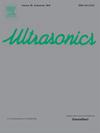表征空气中体积驱动的声流
IF 3.8
2区 物理与天体物理
Q1 ACOUSTICS
引用次数: 0
摘要
采用粒子图像测速技术(PIV)对两种不同的高功率超声源在空气中诱导的体积驱动声流进行了测量和表征。这些时间平均流是由声波能量衰减驱动的,在声波传播的方向上表现为射流。Langevin喇叭和聚焦换能器阵列分别在f≈27 kHz和f=40 kHz的声频下工作,用于产生高压声场,局部声压级超过160 dB。朗格万角和聚焦阵列产生的声流强度分别高达Vmax≈0.15m/s和Vmax≈0.2m/s。对于给定的峰值声压,由于高驱动频率下的声衰减增加,聚焦阵列产生更高的声流速度。研究发现,声场的形状决定了声流速度场的形状,与聚焦阵列相比,朗格万角产生的射流更宽,速度的增加和衰减更平缓。聚焦阵列产生了一个流速度场,其中最大速度发生在声压峰值相似的位置。将实验PIV结果与基于弱非线性假设的一阶压力衰减驱动流场的数值模型进行了比较。该数值模型对流场的预测具有较好的定性和定量一致性。本文章由计算机程序翻译,如有差异,请以英文原文为准。
Characterising bulk-driven acoustic streaming in air
Bulk-driven acoustic streaming flows induced by two different high-powered ultrasonic sources in air have been measured and characterised using particle image velocimetry (PIV). These time-averaged flows are driven by the attenuation of the acoustic energy, and appear as jets in the direction of the acoustic propagation. Langevin horns and a focussed array of transducers, which operate at acoustic frequencies of kHz and kHz respectively, were used to create high pressure acoustic fields, with local sound pressure levels of over 160 dB. The magnitude of the acoustic streaming flows that resulted from the Langevin horn and the focussed array were up to and respectively. For a given peak acoustic pressure, the focussed array yielded higher acoustic streaming velocities due to the increased acoustic attenuation at the higher driving frequency. The shape of the acoustic field was found to govern the shape of the acoustic streaming velocity field, with the Langevin horn producing a wider jet with a more gradual velocity increase and decay than the focussed array. The focussed array induced a streaming velocity field where the maximum velocity occurred at a similar location to the peak acoustic pressure. Experimental PIV results were compared to a numerical model based on assumed weak non-linearity in which the attenuation of the first order pressure drives the streaming. The numerical model was able to predict the streaming velocity field with good qualitative and reasonable quantitative agreement.
求助全文
通过发布文献求助,成功后即可免费获取论文全文。
去求助
来源期刊

Ultrasonics
医学-核医学
CiteScore
7.60
自引率
19.00%
发文量
186
审稿时长
3.9 months
期刊介绍:
Ultrasonics is the only internationally established journal which covers the entire field of ultrasound research and technology and all its many applications. Ultrasonics contains a variety of sections to keep readers fully informed and up-to-date on the whole spectrum of research and development throughout the world. Ultrasonics publishes papers of exceptional quality and of relevance to both academia and industry. Manuscripts in which ultrasonics is a central issue and not simply an incidental tool or minor issue, are welcomed.
As well as top quality original research papers and review articles by world renowned experts, Ultrasonics also regularly features short communications, a calendar of forthcoming events and special issues dedicated to topical subjects.
 求助内容:
求助内容: 应助结果提醒方式:
应助结果提醒方式:


